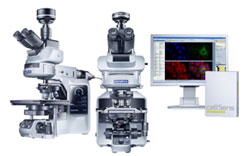
BX3 Research Microscope Systems
Olympus Europa SE & Co. KGRequest Info
Olympus Europa Holding GmbH has launched the BX3 upright research microscope systems that let users define their own working environments: from the microscope and imaging components, to software work flows and GUIs, to the positioning of the controls on the desktop.
The manual BX53 frame offers system flexibility with optional coded and automated modules, and the BX63 frame provides advanced automation as standard. The microscopes combine with imaging modules, cameras and cellSens software.
 A programmable touch-panel control simplifies observation and imaging tasks and can be placed wherever the user wants. It controls all of the components of the imaging system, enabling users to change the objective, mirror unit and observation method, as well as navigate and focus the sample.
A programmable touch-panel control simplifies observation and imaging tasks and can be placed wherever the user wants. It controls all of the components of the imaging system, enabling users to change the objective, mirror unit and observation method, as well as navigate and focus the sample.
The microscope can be fitted with a detachable remote control to provide the effect of traditional mechanical knobs for focus (Z) and stage position (X-Y). The unit features buttons for changing between observation methods, objectives and mirror units, as well as for adjusting light intensity. The X-Y stage control can be fixed on either side of the main control unit, or even separated from it.
Many of the optical adjustments required upon changing between contrast methods are automated, including condenser position, top lens, aperture stop, field stop, polarizer, fluorescence shutter, mirror turret position and light intensity, according to the respective objective and contrast method selected.
On the BX53, the transmitted attenuation filters and fluorescence shutters can be operated from either side of the frame, which also features the centrally positioned illumination intensity control dial. The ergonomic fine-focus adjustment handle can be placed on the left or the right to match the position of the stage handle, which also is available in left- or right-handed configurations. If the microscope is fitted with a proprietary digital camera, the optical path switch can be attached on both sides of the ergonomic tilting tube. For documentation convenience, a remote exposure button is available, which can be freely placed.
As well as the standard halogen light source, the Olympus BX63 can be fitted with a true-color LED system that provides a color rendering index matching that of a halogen bulb with a daylight filter. This provides high color clarity across the range of bright-field stains. A lifetime of ~20,000 h and the low power consumption of the LED result in low operating costs and reduced downtime.
The fluorescence illumination concept is based around the fly-eye lens system which provides homogeneity for fluorescence illumination, ensuring even illumination across the entire field of view at any wavelength. This, coupled with high transmission and minimal autofluorescence of the entire optical pathway, renders the microscopes suitable for fluorescence microscopy.
The eight-position filter turret enables multicolor fluorescence studies and offers fast, tool-free mirror cube exchange. The cubes are designed to maximize the signal-to-noise ratio by capturing >99% of stray light and using multilayer filters with steep cutoffs for highly defined wavelength selection. The signal-to-noise ratio is further improved through the use of the company’s low-autofluorescence immersion oil.
Users can employ mercury, xenon or Exfo X-Cite arc burners and CoolLED fluorescent LED systems for fluorescence illumination.
The optional coded nosepiece and mirror turret modules enable automatic recording and sharing of microscope magnification and setting information for comparing, measuring and scaling images. Available motorization components include a universal condenser, and a neutral density filter wheel and stage.
The microscopes are completely motorized and are focused via the nosepiece rather than the stage, enabling the stage to be fixed and increasing its stability. The stage is driven by ultrasonic piezo technology, providing silent, smooth operation. It can be positioned by hand, enabling rapid gross sample alignment while encoders continuously read out the X-Y position. The encoding enables the user to set precise coordinates and navigate directly to them at high speeds.
The cellSens software controls complex imaging processes such as multiple image alignment, and multiposition or Z-stack acquisition.
http://www.olympus-ims.com
/Buyers_Guide/Olympus_Europa_SE_Co_KG/c10690
Published: October 2010
REQUEST INFO ABOUT THIS PRODUCT
* First Name:
* Last Name:
* Email Address:
* Company:
* Country:
Message:
When you click "Send Request", we will record and send your personal contact information to Olympus Europa SE & Co. KG by email so they may respond directly. You also agree that Photonics Media may contact you with information related to this inquiry, and that you have read and accept our
Privacy Policy and
Terms and Conditions of Use.
Register or login to auto-populate this form:
Login
Register
* Required